Lafcadio Hearn
| Lafcadio Hearn Koizumi Yakumo (小泉八雲) | |
|---|---|
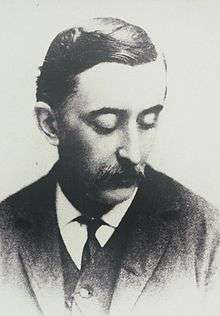 Lafcadio Hearn in 1889 by Frederick Gutekunst | |
| Born |
Patrick Lafcadio Hearn 27 June 1850 Lefkada, United States of the Ionian Islands |
| Died |
26 September 1904 (aged 54) Tokyo, Japan |
| Pen name | Koizumi Yakumo |
| Language | English |
| Nationality | Irish, Greek |
| Alma mater | Ushaw College, University of Durham, England |
| Spouse |
Alethea ("Mattie") Foley Koizumi Setsu |
Patrick Lafcadio Hearn (/hɜːrn/; 27 June 1850 – 26 September 1904), known also by the Japanese name Koizumi Yakumo (小泉 八雲), was an international writer, known best for his books about Japan, especially his collections of Japanese legends and ghost stories, such as Kwaidan: Stories and Studies of Strange Things. In the United States, Hearn is also known for his writings about the city of New Orleans based on his ten-year stay in that city.
Life
Early life
Hearn was born in and named for the island of Lefkada, one of the Greek Ionian Islands, on 27 June 1850.[1]:p. 3 He was the son of Surgeon-Major Charles Bush Hearn (of County Offaly, Ireland) and Rosa Antoniou Kassimatis, a Greek woman of noble Kytheran lineage through her father, Anthony Kassimatis. His father was stationed in Lefkada during the British occupation of the islands, where he was the highest-ranking surgeon in his regiment. Lafcadio was baptized Patricios Lefcadios Hearn (Πατρίκιος Λευκάδιος Χερν) in the Greek Orthodox Church, but he seems to have been called "Patrick Lefcadio Kassimati Charles Hearn" in English.[2] Hearn's parents were married in a Greek Orthodox ceremony on 25 November 1849, several months after his mother had given birth to the couple's first child and Hearn's older brother, George Robert Hearn, on 24 July 1849. George Hearn died on 17 August 1850, two months after Lafcadio's birth.[3]: p. 11
Emigration to Ireland, abandonment
A complex series of conflicts and events led to Lafcadio Hearn being moved from Greece to Ireland, where he was abandoned first by his mother (leaving him in the care of her husband's aunt), then his father, and finally by his father's aunt, who had been appointed his official guardian.
In 1850 Hearn's father was promoted to Staff Surgeon Second Class and was reassigned from Lefkada to the British West Indies. Since his family did not approve of the marriage, and worried that his relationship might harm his career prospects, Charles Hearn did not inform his superiors of his son or pregnant wife and left his family behind. In 1852, he arranged to send his son and wife to live with his family in Dublin, Ireland, where they received a cool reception. Charles Hearn's mother, Elizabeth Holmes Hearn, had difficulty accepting Rosa Hearn's Catholicism and lack of education (she was illiterate and spoke no English). Rosa found it difficult to adapt to a foreign culture and the Protestantism of her husband's family, and was eventually taken under the wing of Elizabeth's sister, Sara Holmes Brenane, a widow who had converted to Catholicism.
Despite Sarah Brenane's efforts, Rosa suffered from homesickness. When her husband returned to Ireland on medical leave in 1853, it became clear that the couple had become estranged. Charles Hearn was assigned to the Crimean Peninsula, again leaving his pregnant wife and child in Ireland. When he came back in 1856, severely wounded and traumatized, Rosa had returned to her home island of Cerigo in Greece, where she gave birth to their third son, Daniel James Hearn. Lafcadio had been left in the care of Sarah Brenane.
Charles Hearn petitioned to have the marriage with Rosa annulled, on the basis of her lack of signature on the marriage contract, which made it invalid under English law. After being informed of the annulment, Rosa almost immediately married Giovanni Cavallini, a Greek citizen of Italian ancestry who was later appointed by the British as governor of Cerigotto. Cavallini required as a condition of the marriage that Rosa give up custody of both Lafcadio and James. As a result, James was sent to his father in Dublin and Lafcadio remained in the care of Sarah Brenane (Brenane had disinherited Charles Hearn because of the annulment). Neither Lafcadio nor James saw their mother again, who had four children with her second husband. Rosa was eventually committed to the National Mental Asylum on Corfu, where she died in 1882.[3]:pp. 14–15
Charles Hearn, who had left Lafcadio in the care of Sarah Brenane for the past 4 years, now appointed her as Lafcadio's permanent guardian. He married his childhood sweetheart, Alicia Goslin, in July 1857, and left with his new wife for a posting in Secunderabad, where they had three daughters prior to Alicia's death in 1861. Lafcadio never saw his father again: Charles Hearn died of malaria in the Gulf of Suez in 1866.[3]:pp. 17–18
In 1857, at age seven and despite the fact that both his parents were still alive, Hearn became the permanent ward of his great aunt, Sarah Brenane. She divided her residency between Dublin in the winter months, her husband's estate at Tramore, County Waterford on the southern Irish coast, and a house at Bangor, North Wales. Brenane also engaged a tutor during the school year to provide basic instruction and the rudiments of Catholic dogma. Hearn began exploring Brenane's library and read extensively in Greek literature, especially myths.[3]:pp. 20–22
Catholic education, abandonment
In 1861, Hearn's aunt, aware that Hearn was turning away from Catholicism, and at the urging of Henry Hearn Molyneux, a relative of her late husband and a distant cousin of Hearn, enrolled him at the Institution Ecclésiastique, a Catholic church school in Yvetot, France. Hearn's experiences at the school confirmed his lifelong conviction that Christian education consisted of "conventional dreariness and ugliness and dirty austerities and long faces and Jesuitry and infamous distortion of children's brains."[3]:p. 25 Hearn became fluent in French and would later translate into English the works of Guy de Maupassant, who coincidentally attended the school shortly after Hearn's departure.
In 1863, again at the suggestion of Molyneux, Hearn was enrolled at St. Cuthbert's College, Ushaw, a Catholic seminary at what is now the University of Durham. In this environment, Hearn adopted the nickname "Paddy" to try to fit in better, and was the top student in English composition for three years.[3]:p. 26 At age 16, while at Ushaw, Hearn injured his left eye in a schoolyard mishap. The eye became infected and, despite consultations with specialists in Dublin and London, and a year spent out of school convalescing, went blind. Hearn also suffered from severe myopia, so his injury left him permanently with poor vision, requiring him to carry a magnifying glass for close work and a pocket telescope to see anything beyond a short distance (Hearn avoided eyeglasses, believing they would gradually weaken his vision further). The iris was permanently discolored, and left Hearn self-conscious about his appearance for the rest of his life, causing him to cover his left eye while conversing and always posing for the camera in profile so that the left eye was not visible.[1]:p. 35
In 1867, Henry Molyneux, who had become Sarah Brenane's financial manager, went bankrupt, along with Brenane. There was no money for tuition, and Hearn was sent to London's East End to live with Brenane's former maid. She and her husband had little time or money for Hearn, who wandered the streets, spent time in workhouses, and generally lived an aimless, rootless existence. His main intellectual activities consisted of visits to libraries and the British Museum.[3]:pp. 29–30
Emigration to Cincinnati
By 1869, Henry Molyneux had recovered some financial stability and Brenane, now 75, was infirm. Resolving to end his expenditures on the 19-year-old Hearn, he purchased a one-way ticket to New York and instructed Hearn to find his way to Cincinnati, to locate Molyneux's sister and her husband, Thomas Cullinan, and to obtain their assistance in making a living. Upon meeting Hearn in Cincinnati, the family had little assistance to offer: Cullinan gave him $5 and wished him luck in seeking his fortune. As Hearn would later write, "I was dropped moneyless on the pavement of an American city to begin life."[4]:p. 818
For a time, he was impoverished, living in stables or store rooms in exchange for menial labor.[5] He eventually befriended the English printer and communalist Henry Watkin, who employed him in his printing business, helped find him various odd jobs, lent him books from his library, including utopianists Fourier, Dixon and Noyes, and gave Hearn a nickname which stuck with him for the rest of his life, The Raven, from the Poe poem. Hearn also frequented the Cincinnati Public Library, which at that time had an estimated 50,000 volumes. In the spring of 1871 a letter from Henry Molyneux informed him of Sarah Brenane's death and Molyneux's appointment as sole executor. Despite Brenane having named him as the beneficiary of an annuity when she became his guardian, Hearn received nothing from the estate and never heard from Molyneux again.[3]:pp. 36–37
Newspaper and literary work
By the strength of his talent as a writer, Hearn obtained a job as a reporter for the Cincinnati Daily Enquirer, working for the newspaper from 1872 to 1875. Writing with creative freedom in one of Cincinnati's largest circulating newspapers, he became known for his lurid accounts of local murders, developing a reputation as the paper's premier sensational journalist, as well as the author of sensitive accounts of some of the disadvantaged people of Cincinnati. The Library of America selected one of these murder accounts, Gibbeted, for inclusion in its two-century retrospective of American True Crime, published in 2008.[6] After one of his murder stories, the Tanyard Murder, had run for several months in 1874, Hearn established his reputation as Cincinnati's most audacious journalist, and the Enquirer raised his salary from $10 to $25 per week.[3]:p. 54

In 1874 Hearn and the young Henry Farny, later a renowned painter of the American West, wrote, illustrated, and published an 8-page weekly journal of art, literature and satire entitled Ye Giglampz. The Cincinnati Public Library reprinted a facsimile of all nine issues in 1983. The work was considered by a twentieth century critic to be 'Perhaps the most fascinating sustained project he undertook as an editor.'[7]
Marriage, firing by the Enquirer
On 14 June 1874, Hearn, aged 23, married Alethea ("Mattie") Foley, a 20-year-old African American woman, an action in violation of Ohio’s anti-miscegenation law at that time. In August 1875, in response to complaints from local clergyman about his anti-religious views and pressure from local politicians embarrassed by some of his satirical writing in Ye Giglampz, the Enquirer fired him, citing as its reason his illegal marriage. He went to work for the rival newspaper The Cincinnati Commercial. The Enquirer offered to re-hire after his stories began appearing in the Commercial and its circulation began increasing, but Hearn, incensed at the paper's behavior, refused. Hearn and Foley separated, but attempted reconciliation several times before divorcing in 1877. Foley remarried in 1880.[3]:pp. 82, 89
While working for the Commercial Hearn agreed to be carried to the top of Cincinnati's tallest building on the back of a famous steeplejack, Joseph Roderiguez Weston, and wrote a half-terrified, half-comic account of the experience. It was also during this time that Hearn wrote a series of accounts of the Bucktown and Levee neighborhoods of Cincinnati, "...one of the few depictions we have of black life in a border city during the post-Civil War period."[3]:p. 98 He also wrote about local black song lyrics from the era, including a song titled "Shiloh" that was dedicated to a Bucktown resident named "Limber Jim."[8]
New Orleans
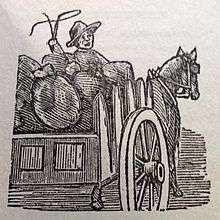
During the autumn of 1877, recently divorced from Mattie Foley and restless, Hearn had begun neglecting his newspaper work in favor of translating into English works of the French author Gautier. He had also grown increasingly disenchanted with Cincinnati, writing to Henry Watkin, "It is time for a fellow to get out of Cincinnati when they begin to call it the Paris of America." With the support of Watkin and Cincinnati Commercial publisher Murat Halstead, Hearn left Cincinnati for New Orleans, where he initially wrote dispatches on the "Gateway to the Tropics" for the Commercial.
Hearn lived in New Orleans for nearly a decade, writing first for the newspaper Daily City Item beginning in June 1878, and later for the Times Democrat. Since the Item was a 4-page publication, Hearn's editorial work changed the character of the newspaper dramatically. He began at the Item as a news editor, expanding to include book reviews of Bret Harte and Émile Zola, summaries of pieces in national magazines such as Harper's, and editorial pieces introducing Buddhism and Sanskrit writings. As editor, Hearn created and published nearly two hundred woodcuts of daily life and people in New Orleans, making the Item the first Southern newspaper to introduce cartoons and giving the paper an immediate boost in circulation. Hearn gave up carving the woodcuts after six months when he found the strain was too great for his eye.[3]:p. 134
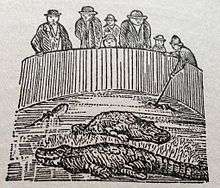
At the end of 1881 Hearn took an editorial position with the New Orleans Times Democrat and was employed translating items from French and Spanish newspapers as well as writing editorials and cultural reviews on topics of his choice. He also continued his work translating French authors into English: Gérard de Nerval, Anatole France, and most notably Pierre Loti, an author who influenced Hearn's own writing style.[3]: pp. 130–131 Milton Bronner, who edited Hearn's letters to Henry Watkin, wrote "[T]he Hearn of New Orleans was the father of the Hearn of the West Indies and of Japan," and this view was endorsed by Norman Foerster.[9]
The vast number of his writings about New Orleans and its environs, many of which have not been collected, include the city's Creole population and distinctive cuisine, the French Opera, and Louisiana Voodoo. Hearn wrote enthusiastically of New Orleans, but also wrote of the city's decay, "a dead bride crowned with orange flowers".[3]:p. 118
Hearn's writings for national publications, such as Harper's Weekly and Scribner's Magazine, helped create the popular reputation of New Orleans as a place with a distinct culture more akin to that of Europe and the Caribbean than to the rest of North America. Hearn's best-known Louisiana works include:
- Gombo zhèbes: Little dictionary of Creole proverbs (1885)
- La Cuisine Créole (1885), a collection of culinary recipes from leading chefs and noted Creole housewives who helped make New Orleans famous for its cuisine
- Chita: A Memory of Last Island (1889), a novella based on the hurricane of 1856 first published in Harper's Monthly in 1888
Hearn also published in Harper's Weekly the first known written article (1883) about Filipinos in the United States, the Manilamen or Tagalogs, one of whose villages he had visited at Saint Malo, southeast of Lake Borgne in St. Bernard Parish, Louisiana.
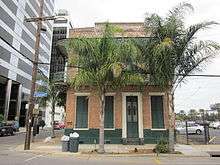
At the time he lived there, Hearn was little known, and even now he is little known for his writing about New Orleans, except by local cultural devotees. However, more books have been written about him than any former resident of New Orleans except Louis Armstrong.[10]
Hearn's writings for the New Orleans newspapers included impressionistic descriptions of places and characters and many editorials denouncing political corruption, street crime, violence, intolerance, and the failures of public health and hygiene officials. Despite the fact that he is credited with "inventing" New Orleans as an exotic and mysterious place, his obituaries of the vodou leaders Marie Laveau and Doctor John Montenet are matter-of-fact and debunking. Selections of Hearn's New Orleans writings have been collected and published in multiple works, starting with Creole Sketches[11] in 1924, and more recently in Inventing New Orleans: Writings of Lafcadio Hearn.[12]
Two Years in the French West Indies
Harper's sent Hearn to the West Indies as a correspondent in 1887. He spent two years in Martinique and in addition to his writings for the magazine, produced two books: Two Years in the French West Indies and Youma, The Story of a West-Indian Slave, both published in 1890.
Later life in Japan
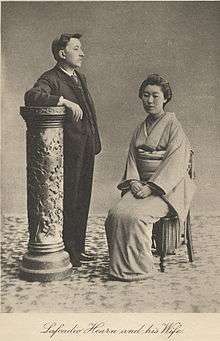
In 1890, Hearn went to Japan with a commission as a newspaper correspondent, which was quickly terminated. It was in Japan, however, that he found a home and his greatest inspiration. Through the goodwill of Basil Hall Chamberlain, Hearn gained a teaching position during the summer of 1890 at the Shimane Prefectural Common Middle School and Normal School in Matsue, a town in western Japan on the coast of the Sea of Japan. The Lafcadio Hearn Memorial Museum and his old residence are still two of Matsue's most popular tourist attractions. During his fifteen-month stay in Matsue, Hearn married Koizumi Setsu, the daughter of a local samurai family, with whom he had four children.[13] He became a naturalized Japanese, assuming the name Koizumi Yakumo, in 1896 after accepting a teaching position in Tokyo. After having been Greek Orthodox, Roman Catholic, and, later on, Spencerian, he became Buddhist.[14]
During late 1891, Hearn obtained another teaching position in Kumamoto, Kyūshū, at the Fifth Higher Middle School, where he spent the next three years and completed his book Glimpses of Unfamiliar Japan (1894). In October 1894, he secured a journalism job with the English-language newspaper Kobe Chronicle, and in 1896, with some assistance from Chamberlain, he began teaching English literature at Tokyo Imperial University, a job he had until 1903. In 1904, he was a professor at Waseda University.
While in Japan he encountered the art of ju-jutsu which made a deep impression upon him:[15]
| “ | Hearn, who encountered judo in Japan at the end of the nineteenth century, contemplated its concepts with the awed tones of an explorer staring about him in an extraordinary and undiscovered land. "What Western brain could have elaborated this strange teaching, never to oppose force by force, but only direct and utilize the power of attack; to overthrow the enemy solely through his own strength, to vanquish him solely by his own efforts? Surely none! The Western mind appears to work in straight lines; the Oriental, in wonderful curves and circles." | ” |
On 26 September 1904, he died of heart failure at the age of 54 years. His grave is at the Zōshigaya Cemetery in Toshima, Tokyo.
In the late 19th century, Japan was still largely unknown and exotic to Westerners. However, with the introduction of Japanese aesthetics, particularly at the Paris Exposition Universelle of 1900, Japanese styles became fashionable in Western countries. Consequently, Hearn became known to the world by his writings concerning Japan. In later years, some critics would accuse Hearn of exoticizing Japan, but because he offered the West some of its first descriptions of pre-industrial and Meiji Era Japan, his work has historical value.[16][17][18]
Legacy
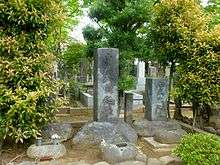
Admirers of Hearn's work have included Ben Hecht,[19] John Erskine, and Malcolm Cowley.[20]
The Japanese director Masaki Kobayashi adapted four Hearn tales into his 1964 film, Kwaidan. Some of his stories have been adapted by Ping Chong into his puppet theatre, including the 1999 Kwaidan and the 2002 OBON: Tales of Moonlight and Rain.
Hearn's life and works were celebrated in The Dream of a Summer Day, a play that toured Ireland during April and May 2005, which was staged by the Storytellers Theatre Company and directed by Liam Halligan. It is a detailed dramatization of Hearn's life, with four of his ghost stories included.
Yone Noguchi is quoted as saying about Hearn, "His Greek temperament and French culture became frost-bitten as a flower in the North."[21]
There is also a cultural center named for Hearn at the University of Durham.
Hearn was a major translator of the short stories of Guy de Maupassant.[22]
The first museum in Europe for Lafcadio Hearn was inaugurated in Lefkada, Greece, his birthplace, on 4 July 2014, as Lefcadio Hearn Historical Center. It contains early editions, rare books and Japanese collectibles. The visitors, through photos, texts and exhibits, can wander in the significant events of Lafcadio Hearn's stunning life, but also in the civilizations of Europe, America and Japan of the late eighteenth and early nineteenth centuries through the open mind of his lectures, writings and tales. The municipalities of Kumamoto, Matsue, Shinjuku, Yaizu, Toyama University, Koizumi family and other people from Japan and Greece contributed to the establishment of Lefcadio Hearn Historical Center.
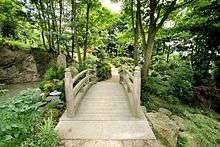
Gardens have been created in memory of Lafcadio Hearn in the town of Tramore, County Waterford, Ireland. The Lafcadio Hearn Japanese Gardens reflect the life and extensive wanderings Lafcadio Hearn (Koizumi Yakumo) and tell the wonderful and unique story of his life. In their style and planting they contain elements of the gardening traditions of the countries and cultures traversed by Hearn. The journey begins in a Victorian Garden to commemorate Hearn’s happy childhood summers in Tramore with his gran aunt Sarah Brenane. There is an American Garden, a Greek Garden and a traditional Japanese Tea Garden, in addition to a Stream Garden, ponds, a waterfall and an extensive woodland area. The main elements of design, in particular the use of rocks and water and the plant selection, are influenced by the tradition of a Japanese Strolling Garden.[23]
Works
_Glimpses_of_unfamiliar_Japan.jpg)
Books written by Hearn on Japanese subjects[24]
- Glimpses of Unfamiliar Japan (1894)
- Out of the East: Reveries and Studies in New Japan (1895)
- Kokoro: Hints and Echoes of Japanese Inner Life (1896)
- Gleanings in Buddha-Fields: Studies of Hand and Soul in the Far East (1897)
- The Boy who Drew Cats, (1897)
- Exotics and Retrospectives (1898)
- Japanese Fairy Tales (1898, and sequels)
- In Ghostly Japan (1899)
- Shadowings (1900)
- Japanese Lyrics (1900)
- A Japanese Miscellany (1901)
- Kottō: Being Japanese Curios, with Sundry Cobwebs (1902)
- Kwaidan: Stories and Studies of Strange Things (1903, later made into the movie Kwaidan by Masaki Kobayashi)
- Japan: An Attempt at Interpretation (1904)
- The Romance of the Milky Way and other studies and stories (1905)
Books written by Hearn on Louisiana subjects
- La Cuisine Creole: A Collection of Culinary Recipes (1885)
- Gombo Zhèbes": A Little Dictionary of Creole Proverbs, Selected from Six Creole Dialects. (1885)
- Chita: A Memory of Last Island (1889)
- Creole Sketches (1924, Houghton Mifflin)
Posthumous anthologies
- Letters from the Raven; being the correspondence of Lafcadio Hearn with Henry Watkin (1907)
- Includes Letters from the Raven, 'Letters to a Lady, Letters of Ozias Midwinter
- Leaves from the Diary of an Impressionist (1911, Houghton Mifflin Company)
- Interpretations of Literature (1915, Dodd, Mead and Company)
- Karma (1918)
- On Reading in Relation to Literature (1921, The Atlantic Monthly Press, Inc.)
- Lectures on Shakespeare (1928, Hokuseido Press)
- Insect-musicians and other stories and sketches (1929)
- Japan's Religions: Shinto and Buddhism (1966)
- Books and Habits; from the Lectures of Lafcadio Hearn (1968, Books for Libraries Press)
- Writings from Japan: An Anthology (1984), Penguin Books)
- Lafcadio Hearn's America: Ethnographic Sketches and Editorials (2002, University Press of Kentucky)
- Lafcadio Hearn's Japan: An Anthology of His Writings on the Country and Its People (2007, Tuttle)
- American Writings (2009, Library of America)
- Insect Literature (2015, Swan River Press; for details, see Insects in literature)
Other
- One of Cleopatra's Nights and Other Fantastic Romances (1882, translation of stories by Théophile Gautier), Richard Worthington
- Stray Leaves From Strange Literature; Stories Reconstructed from the Anvari-Soheili, Baital Pachisi, Mahabharata, Pantchantra, Gulistan, Talmud, Kalewala, etc.(1884, James R. Osgood and Company)
- Some Chinese Ghosts (1887)
- Youma, the Story of a West-Indian Slave (1889)
- Two Years in the French West Indies (1890)
See also
References
-
 This article incorporates text from a publication now in the public domain: Chisholm, Hugh, ed. (1911). "article name needed". Encyclopædia Britannica (11th ed.). Cambridge University Press.
This article incorporates text from a publication now in the public domain: Chisholm, Hugh, ed. (1911). "article name needed". Encyclopædia Britannica (11th ed.). Cambridge University Press.
- 1 2 Bisland, Elizabeth (1906). The life and letters of Lafcadio Hearn. 1. Boston: Houghton, Mifflin.
- ↑ According to one of his biographers, a family Bible records 'Patricio Lafcadio Tessima Carlos Hearn, August 1850.' Kennard, Nina H. (1912). Lafcadio Hearn. New York: D. Appleton and Co.
- 1 2 3 4 5 6 7 8 9 10 11 12 13 14 Cott, Jonathan (1990). Wandering Ghost: The Odyssey of Lafcadio Hearn. New York: Knopf.
- ↑ Christopher Benfey, ed. (2008). Lafcadio Hearn: American Writings. New York: Library of America. ISBN 978-1-59853-039-1.
- ↑ Grace, Kevin (4 January 2012). Legendary Locals of Cincinnati. Arcadia Publishing. p. 25. Retrieved 7 May 2013.
- ↑ Harold Schechter, ed. (2008). True Crime: An American Anthology. Library of America. pp. 117–130. ISBN 978-1-59853-031-5.
- ↑ Jon Christopher Hughes (Autumn 1982). ""Ye Giglampz" and the Apprenticeship of Lafcadio Hearn". American Literary Realism, 1870–1910. University of Illinois Press. 15 (2): 182–194. JSTOR 27746052.
- ↑ Gale, Robert (2002). A Lafcadio Hearn Companion. Greenwood Press. pp. 179–180. ISBN 0-313-31737-2.
- ↑ Norman Foerster (1934), American Poetry and Prose, Revised and Enlarged Edition, Boston: Houghton Mifflin, p. 1149; Hearn, Lafcadio (1907), Letters from the Raven: Being the Correspondence of Lafcadio Hearn with Henry Watkin, ed., Milton Bronner, New York: Brentano's.
- ↑ Peggy Grodinsky (14 February 2007). "A chronicle of Creole cuisine". Chronicle. Houston..
- ↑ Lafcadio Hearn (1924). Charles Woodward Hutson, ed. Creole Sketches. Boston: Houghton Mifflin Co. OCLC 2403347.
- ↑ Starr, S. Frederick (2001). Inventing New Orleans: Writings of Lafcadio Hearn. University Press of Mississippi. ISBN 1-57806-353-1.
- ↑ Kazuo, Iwao, Kiyoshi, and Suzuko: Katharine Chubbuck, ‘Hearn, (Patricio) Lafcadio Carlos (1850–1904)’, Oxford Dictionary of National Biography, Oxford University Press, 2004
- ↑ Norman Foerster (1934), American Poetry and Prose, Revised and Enlarged Edition, Boston: Houghton Mifflin, p. 1149.
- ↑ Law, Mark (2007). The Pyjama Game: A Journey Into Judo (2008 ed.). London: Aurum Press Ltd. p. 41.
- ↑ Komakichi, Nohara, The True Face of Japan, (1936, 1st ed.)
- ↑ Guo, Nanyang (2000), Interpreting Japan's interpreters: the problem of Lafcadio Hearn, New Zealand Journal of Asian Studies 3 (1), 106–118
- ↑ Askew, Rie (2009), The Critical Reception of Lafcadio Hearn outside Japan, New Zealand Journal of Asian Studies 11 (2), 44–71
- ↑ MacAdams, William (1995), Ben Hecht, Barricade, p. 34, ISBN 1-56980-028-6.
- ↑ Cowley, Malcolm (1949), "Introduction", in Goodman, Henry, The Selected Writings of Lafcadio Hearn, Citadel.
- ↑ Noguchi, Yone (1910), Lafcadio Hearn in Japan, New York: Mitchell Kennerley.
- ↑ "Bibliography", Lafcadio Hearn, Trussel.
- ↑ www.lafcadiohearngardens.com
- ↑ Hearn's Works, http://www.trussel.com/hearn/byhearn.htm
Further reading
- Amenomori, Nobushige (1905). "Lafcadio Hearn, the Man," The Atlantic Monthly, October 1905.
- Bisland, Elizabeth (1906). The Life and Letters of Lafcadio Hearn, Vol. II, New York: Houghton, Mifflin & Company.
- Bronner, Milton, ed. (1907), Letters from the Raven: Being the Correspondence of Lafcadio Hearn with Henry Watkin.
- Cott, Jonathan (1992), Wandering Ghost: The Odyssey of Lafcadio Hearn, Kodansha International.
- Dawson, Carl (1992). Lafcadio Hearn and the Vision of Japan, Johns Hopkins University Press.
- Gould, George M. (1908), Concerning Lafcadio Hearn, George W. Jacobs & Company External link in
|title=(help). - Hearn, Lafcadio (2001), Starr, S Frederick, ed., Inventing New Orleans: Writings of Lafcadio Hearn, University Press of Mississippi.
- ——— (2009), "Some Chinese Ghosts, Chita, Two Years in the French West Indies, Youma and Selected Journalism and Letters", in Benfey, Christopher, American Writings, Library of America.
- Kennard, Nina H (1912), Lafcadio Hearn, New York: D. Appleton & Co.
- Kunst, Arthur E. (1969). Lafcadio Hearn, Twayne Publishers.
- Langton, D. H. (1912). "Lafcadio Hearn: Journalist and Writer on Japan," The Manchester Quarterly, Vol. XXXI.
- Lurie, David (2005), "Orientomology: The Insect Literature of Lafcadio Hearn (1850–1904)", in Pflugfelder, Gregory M; Walker, Brett L, JAPANimals: History and Culture in Japan's Animal Life, University of Michigan Press.
- Mais, S. P. B. (1920). "Lafcadio Hearn." In Books and their Writers, Grant Richards, Ltd.
- McWilliams, Vera (1946). Lafcadio Hearn, Houghton Mifflin Company.
- Miner, Earl Roy (1958). The Japanese Tradition in British and American Literature, Princeton University Press.
- Monaham, Michael (1922). "Lafcadio Hearn," An Attic Dreamer, Mitchell Kennerley.
- More, Paul Elmer (1905). "Lafcadio Hearn." In Shelburne Essays, Second Series, G. P. Putnam's Sons.
- Narita, Tatsushi (1911), TS Eliot and his Youth as 'A Literary Columbus', Nagoya: Kougaku Shuppan.
- Noguchi, Yone (1905). "Lafcadio Hearn, A Dreamer," National Magazine, Vol. XXII, No. 1.
- Noguchi, Yone (1910), Lafcadio Hearn in Japan, New York: Mitchell Kennerley External link in
|title=(help). - Pulvers, Roger (19 January 2000), "Lafcadio Hearn: Interpreter of Ttwo Disparate Worlds", Japan Times, Trussel.
- Rexroth, Kenneth (1977), The Buddhist Writings of Lafcadio Hearn.
- Rothman, Adam (2008), "Lafcadio Hearn in New Orleans and the Caribbean", Atlantic Studies, 5 (2); republished in New Orleans in the Atlantic World: Between Land and Sea, Routledge, 2013.
- Setsu, Koizumi (1918). Reminiscences of Lafcadio Hearn, Houghton Mifflin Company.
- Savina, Zoe. "The Golden Book" Dedicated to Lafcadio Hearn. Haiku Poems and Collages. July 2014
Trilingual Book: Greek, English tr. Constantine Fourakis, Japanese tr. Ban'ya Natsuishi
- Starrs, Roy (2006), "Lafcadio Hearn as Japanese Nationalist" (PDF), Nichibunken Japan Review: Journal of the International Research Center for Japanese Studies (essay), JP: Nichibun (18): 181–213.
- Thomas, Edward (1912). Lafcadio Hearn, Houghton Mifflin Company.
External links
| Wikisource has original works written by or about: Lafcadio Hearn |
| Wikiquote has quotations related to: Lafcadio Hearn |
| Wikimedia Commons has media related to Lafcadio Hearn. |
- Hearn's Works, by T Russel
- Works by Lafcadio Hearn at Project Gutenberg
- Works by or about Lafcadio Hearn at Internet Archive
- Works by or about Koizumi Yakumo at Internet Archive
- Works by Lafcadio Hearn at LibriVox (public domain audiobooks)

- Works by Lafcadio Hearn, at Unz.org
- Works by Lafcadio Hearn, at Hathi Trust
- "Lafcadio Hearn and Haiku", Modern haiku (essay).
- Hearn's influence in literature
- "A Journey to Lefcadio Hearn's birthplace", GRJP Web.
- Dirda, Michael, "The Ghost Stories of Lafcadio Hearn", Library without walls (review), Barnes & Noble.
- Lafcadio Hearn's papers at the Albert and Shirley Small Special Collections Library, University of Virginia
- Japan and the Japanese as Seen by Foreigners
- Lafcadio Hearn
- Two Years in the French West Indies From the Collections at the Library of Congress